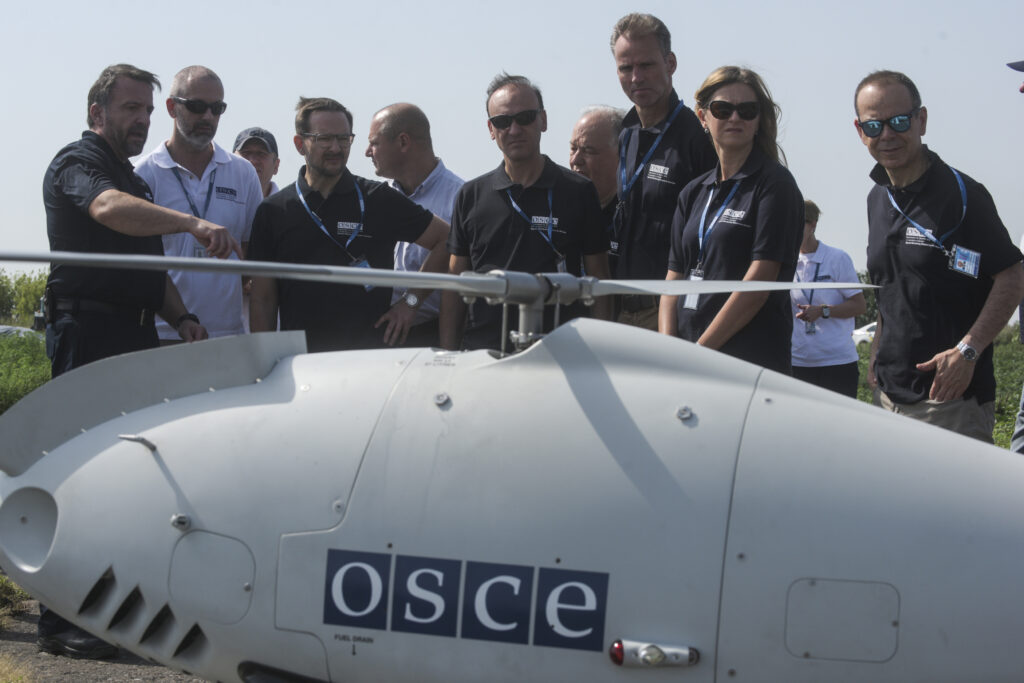
An OSCE drone in Ukraine
WASHINGTON: A drone operated by a group monitoring the war in eastern Ukraine conducted an emergency landing Thursday after its GPS was jammed, a problem that has increasingly plagued its drones since March.
The OSCE’s drones conduct surveillance of the line of contact between Ukrainian government troops and the Russian-backed separatists, while also mapping minefields and tracking the movement of weapons and troops on both sides.
The drone doesn’t appear to have been damaged after landing in a field near its base in Stepanivka, a town about 30 miles from the contested Donbass region, occupied by Russian-backed seperatist forces.
The jamming has long been a concern for the Organization for Security and Cooperation in Europe, a monitoring agency that tracks violations of ceasefire agreements and tracks seperatist and Russian military movements. The EW attacks ramped up this spring just as Moscow surged 110,000 troops near the Ukranian border, causing worries in Kiev and the West that Russian forces would surge into Ukraine.
While some of those troops have pulled back over the past week, most of the armor units left their heavy armor near the border where tens of thousands of Russian infantry troops remain.
Thursday’s incident follows a pattern that began in late March in which drones taking off and landing at one particular site were being jammed throughout their flights. Since March, the OSCE’s “long-range UAVs have been experiencing increased levels of GPS signal interference on take-off and landing, affecting both of their GPS receivers,” the group said in a statement.
The drone had taken off from its base in government-controlled Stepanivka at 12:30pm Thursday “and had immediately experienced dual GPS signal interference, assessed as caused by jamming, which then had occurred at intervals during the flight,” the OSCE said.
By 4 pm, while flying near the separatist-controlled town of Kolosky, it was jammed again, forcing the group to try and pull it back to base.
Between 6:30 and 7 pm, the controller tried three times to land the drone in Emergency Control Mode, the first two of which failed due to continuing GPS interference. The drone eventually landed a few hundreds yards from its designated landing spot.
The group has publicized that it uses the Camcopter S-100 drone with a range of about 110 miles. Austria-based Schiebel makes the Vertical Takeoff and Landing (VTOL) system. They are operated by contractors for the OSCE in Ukraine.
Smaller drones were shot at and jammed this week near government-controlled lines near the town of Lebedynske in the Donetsk region, OSCE reported today, suggesting that both sides may have taken aim at the OSCE’s unmanned assets.
Russian forces in Ukraine and Syria have long showed off their ability to detect and jam drones flown by a variety of groups and governments, and in many ways they’ve led the way in pushing this new way of war.
But what has appeared to have really woken up defense minds in Washington and NATO was last year’s Nagorno-Karabakh war, which saw Azerbaijan use a variety of relatively inexpensive Turkish and Israeli-made drones to obliterate Armenian infantry and armor units, showing that even small nations can pack a big punch in short, sharp conflicts.
The examples of those drone-heavy wars have led to some rethinking about anti-jamming and anti-drone defenses that can deal with the proliferation of small, deadly systems on future battlefields. “We have to ensure that — from an indications and warnings standpoint — our integrated air and missile defense programs take into account the capabilities of these systems,” European Command chief Gen. Tod Wolters told the House Armed Services Committee last month.
The Army is reinvigorating its long-dormant electronic warfare units, and has been investing more heavily in building both offensive and defensive EW capabilities bolted on to existing vehicles like Stryker infantry carriers.
Norway’s top officer on his ‘biggest challenge,’ next frigate and new NATO neighbors
Gen. Eirik Kristoffersen, Norway’s Chief of Defense, talks to Breaking Defense about his plans for spending on new frigates and subs, the challenges of upgrading Norway’s “digital backbone” and refilling the military’s stocks.


























